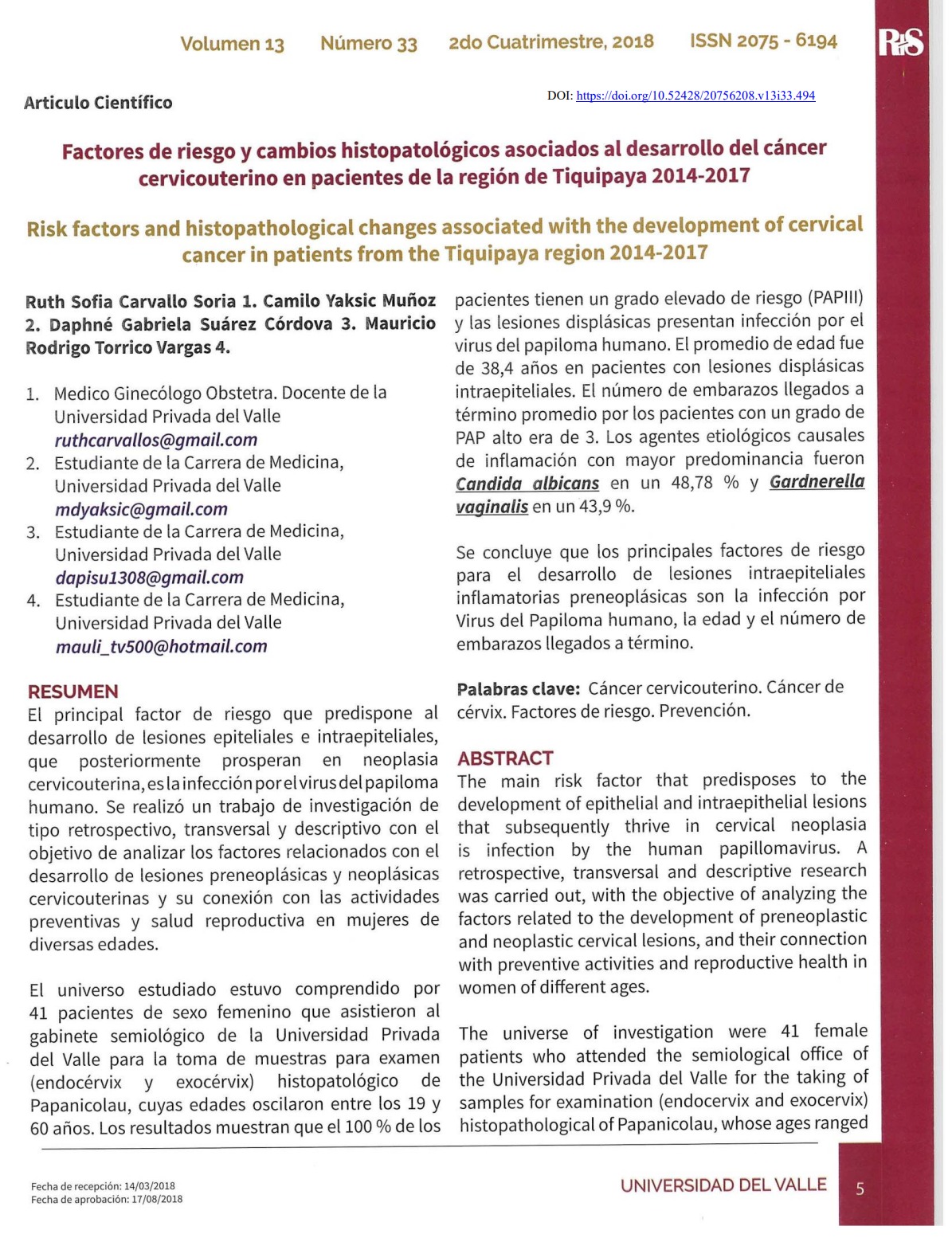Risk factors and histopathological changes associated with the development of cervical cancer in patients from the Tiquipaya region 2014-2017
DOI:
https://doi.org/10.52428/20756208.v13i33.494Keywords:
Cervical cáncer, Cervix cancer, Risk factors, PreventionAbstract
The main risk factor that predisposes to the development of epithelial and intraepithelial lesions that subsequently thrive in cervical neoplasia is infection by the human papillomavirus. A retrospective, transversal and descriptive research was carried out, with the objective of analyzing the factors related to the development of preneoplastic and neoplastic cervical lesions, and their connection with preventive activities and reproductive health in women of different ages.
The universe of investigation were 41 female patients who attended the semiological office of the Universidad Privada del Valle for the taking of samples for examination (endocervix and exocervix) histopathological of Papanicolau, whose ages ranged between 19 to 60 years. The results show that 100 % of patients have a high degree of risk (PAPIII) and dysplastic lesions are infected by human papillomavirus. The average age was 38,4 years in patients with dysplastic intraepithelial lesions. The number of pregnancies reached on average by patients with a high PAP level was 3. The etiologic causative agents of inflammation with the highest prevalence were Candida albicans in 48,78 % and Gardnerella vaginalis in 43,9 %.
lt is concluded that the main risk factors for the development of preneoplastic inflammatory intraepithelial lesions are the infection by Human Papiloma Virus, age and the number of pregnancies reached term.
Downloads
References
TORRICO A, SALAS A, GUTIÉRREZ A, ARCE CARREÓN M y SALAZAR J. Factores de riesgo asociados al inicio de relaciones sexuales en adolescentes mujeres estudiantes de secundaria en La Paz, Bolivia. La Paz, Bolivia: Revista de la Sociedad Boliviana de Pediatría. [Internet]. 2004 [consultado el 11 de diciembre de 2017] 43(1): 3-7. Disponible en: http://_www.scielo.org.bo/_scielo.php?script=sci
CIEZA J, CUEVA F, UCHIYAMA Ey LINARES V. Factores de riesgo en cáncer de cuello uterino. Revista Peruana de Ginecología y
Obstetricia. [Internet] 1997 [Consultado en junio de 2015 43(2): 107-109. ISSN 2304-5132. Disponible en: <http://www.spog.org.pe/_web/revista/index.php/RPGO/article/view/1022. DOI: https://doi.org/10.31403/rpgo.v43i1022
ARPASI C, ARPASI B y CALLE E. Grado de conocimiento sobre el papanicolaou; En mujeres en edad fértil del municipio de Guaqui. La Paz Bolivia: Revista Ciencia y Medicina [Internet] 2007 [Consultado el 24 de febrero de 2018]. Disponible en: http://www.revistasbolivianas.org.bo/_scielo.php?script=sci arttext&pid=S1816-29082007000100003&lng=es.
SANABRIA J, FERNÁNDEZ Z, CRUZ l, PÉREZ L y LLANUCH M. El cáncer cervicouterino y las lesiones precursoras: revisión bibliográfica. Cuba: Revista de Ciencias Médicas [Internet]. 2011 [Consultado el 24 de febrero de 2018] 15(4): 295-319. Disponible en: http://scielo.sld.cu/scielo.php?script=sci arttext&pid=S1561-31942011000400026&lng=es.
DUNÁN L, CALA L, INFANTE N y HERNÁNDEZ T. Factores de riesgo ginecoobstétricos para el cáncer cervicouterino en la atención primaria de salud. Santiago de Cuba, Cuba: MEDISAN [Internet] 2011 [Consultado el 11 de diciembre de 2017] 15 (5): 573-579. Disponible en: http://www.redalyc.org/articulo.oa?id=368445230002
AMARO F, POLO K, MENDOZA DEL PINO M, Pl PARETA L, CARDOSO O. Comportamiento de algunos factores de riesgos asociados a la aparición del cáncer cervicouterino en un área de salud. Cuba: Revista Archivo Médico de Camaguey [Internet]. 2003 [Consultado el 24 de febrero de 2018] 7(6):690-697. Disponible en:
http://scielo.sld.cu/scielo.php?script=sci arttext&pid=S1025-02552003000600002&lng=es.
MORENO V, BOSCH F, MUÑOZ N. Et al. Effect of oral contraceptives on risk of cervical cancer in women with human papillomavirus infection: the IARC multicentric case-control study. Netherlands. Elsevier The Lancet [Internet], 2002 [Consultado el 31 de octubre de 2017]; 359(9312): 1085-92. Disponible en: DOI: https://doi.org/10.1016/S0140-6736(02)08150-3
http://www.thelancet.com/journals/lancet/article/PllS0140-6736(02)08150-3/fulltext
CASTRO RJ, HERNÁNDEZ G y Madrid M. La anticoncepción hormonal como factor de riesgo para cáncer cervicouterino: evidencias biológicas, inmunológicas y epidemiológicas. Ginecol Obstet Mex [Internet]. 2011 [Consultado el 31 de octubre de 2017]; 79(9):533-539. Disponible en: http://www.medigraphic.com/pdfs/ginobsmex/gom-2011/gom119c.pdf
LEWIS M. Análisis de la situación del Cáncer cervicouterino en América Latina y el Caribe. Organización Panamericana de la Salud. Washington DC [Internet]. 2004 [Consultado el 24 de febrero de 2018]. Disponible en: http://iris.paho.org/xmlui/handle/123456789/762
LAU D, MILLÁN M, FAJARDO Y y SÁNCHEZ C. Lesiones preinvasivas del cuello uterino. Ciudad de La Habana: Revista Cubana de Obstetricia y Ginecología [Internet] 2012 [Consultado el 24 de febrero de 2018] 38(3): 366-377. Disponible en: http://scielo.sld.cu/scielo.php?script=sci arttext&pid=S0138-600X2012000300009&lng=es.
ARTEAGA F, ORTEGA V y PONCE F. Cáncer de cuello uterino. Aspectos que tomar en cuenta. Bolivia: Archivos bolivianos de medicina. 2011. Pag. 88.
ROMERO K y ROJAS J. Frecuencia de los factores de riesgo de Cáncer Cervicouterino en mujeres de 14-65 años, Comunidad Ramadas, Provincia Tapacarí-Cochabamba gestión 2012. Cochabamba, Bolivia: Revista Científica Ciencia Médica [Internet] 2012 [Consultado 31 de octubre de 2017] Disponible en:
http://www.scielo.org.bo/scielo.php?script=sci arttext&pid=S1817-74332012000100006&lng=es.
NÚÑEZ J. Cigarrillo y cáncer de cuello uterino. Santiago: Chile: Revista chilena de obstetetricia y ginecología [Internet] 2017 [Consultado el 24 de febrero de 2018] 82(2): 232-240. Disponible en: DOI: https://doi.org/10.4067/S0717-75262017000200014
https://scielo.conicyt.cl/scielo.php?script=sci arttext&pid=S0717-75262017000200014&lng=en&nrm=iso&tlng=en
OLMEDO B, ZEPEDA V, ENRIQUEZ l, RODRIGUEZ A y DELGADO l. El cancer cervico-uterino: implicaciones de la edad de inicio de la vida sexual y el Papilomavirus humano. México Revista Fuente [Internet] 2011[Consultado 31 de octubre de 2017]. Pags. 34-38. Disponible en: http:llfuente.uan.edu.mx/_publicaciones/03-08/_6.pdf
MINISTERIO DE SALUD DE CHILE. Guías Clínicas AUGE Cáncer Cérvico Uterino. Santiago; Revista Minsal [Internet] 2015 [Consultado 31 de octubre de 2017]. Pags. 1-102. Disponible en:
http://www.bibliotecaminsal.cl/wp/wp-contentluploads/20161041GPC-CaCU-Final.PLdocx.pdf
LOPEZA, ALVAREZ J y MURILLO J. Cáncer cervicouterino, Epidemiologia y su Relación con los Factores de Riesgo. Cu liacán, México. Revista Archivos de Salud en Sinaloa [Internet] 2010 [consultado 12 de diciembre 2017] (1):9-13. Disponible en: http://132.248.9.341hevila/ArchivosdesaludenSinaloa/2010/v0141n01/2.pdf.
FERNANDES W y KIMURA M. Calidad de vida relacionada a la salud de mujeres con cáncer de cuello uterino. Sao Paulo, Brasil. Revista Latino-Americana Enfermagem. [Internet] 2010. [consultado 12 de diciembre 2017] Pags. 66-72. Disponible en: http://www.scielo.br/scielo.php?script=sci arttext&pid=S0104-11692010000300010&lng=pt

Downloads
Published
How to Cite
Issue
Section
License
Copyright (c) 2018 Ruth Sofia Carvallo Soria , Camilo Yaksic Muñoz , Daphné Gabriela Suárez Córdova y Mauricio Rodrigo Torrico Vargas

This work is licensed under a Creative Commons Attribution 4.0 International License.
Authors who publish with this journal agree to the following terms:
- Authors retain copyright and grant the journal right of first publication with the work simultaneously licensed under a Creative Commons Attribution License 4.0 that allows others to share the work with an acknowledgement of the work's authorship and initial publication in this journal.
- Authors are able to enter into separate, additional contractual arrangements for the non-exclusive distribution of the journal's published version of the work (e.g., post it to an institutional repository or publish it in a book), with an acknowledgement of its initial publication in this journal.
- Authors are permitted and encouraged to post their work online (e.g., in institutional repositories or on their website) prior to and during the submission process, as it can lead to productive exchanges, as well as earlier and greater citation of published work.






















